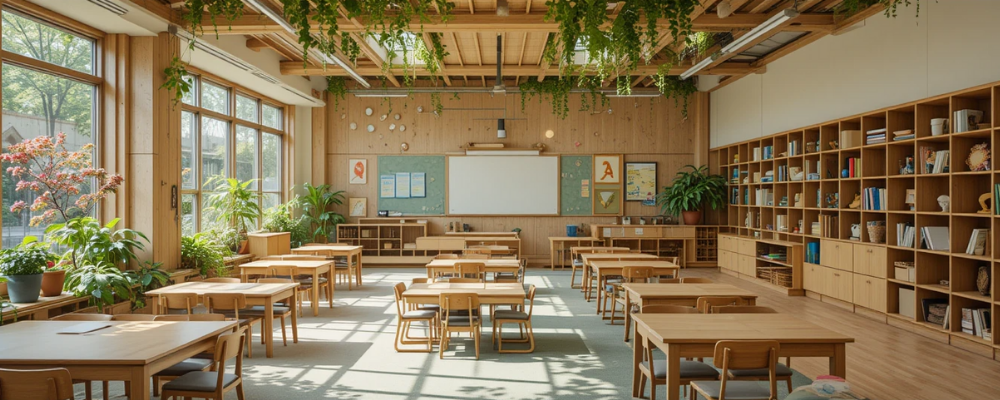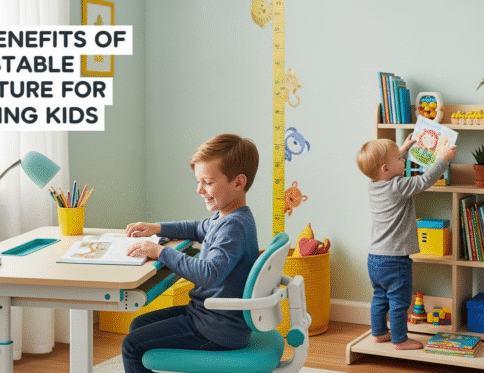In today’s fast-paced, technology-driven world, students often spend most of their time indoors, disconnected from nature. However, research shows that incorporating natural elements into learning environments can have profound benefits for students’ well-being, focus, and academic performance. This is where biophilic design comes in. Biophilic design is an innovative approach that integrates nature into built environments, creating spaces that inspire, calm, and energize. In this blog post, we’ll explore how biophilic design can transform classrooms and provide practical tips for bringing nature into learning spaces.
What is Biophilic Design?
Biophilic design is rooted in the concept of biophilia, which refers to humans’ innate connection to nature. This design philosophy emphasizes the use of natural materials, patterns, and elements to create environments that mimic the outdoors. In classrooms, biophilic design can include everything from indoor plants and natural lighting to nature-inspired colors and textures.
The Benefits of Biophilic Design in Classrooms
- Improves Mental Well-Being Studies have shown that exposure to nature reduces stress, anxiety, and fatigue. By incorporating natural elements into classrooms, students can feel calmer and more relaxed, creating a positive atmosphere for learning.
- Enhances Focus and Concentration Natural light, greenery, and views of nature have been linked to improved attention spans and cognitive function. A well-designed biophilic classroom can help students stay focused and engaged during lessons.
- Boosts Creativity and Problem-Solving Nature-inspired environments stimulate creativity and encourage out-of-the-box thinking. This is especially important in classrooms, where students are often tasked with solving complex problems and thinking critically.
- Promotes Physical Health Biophilic design often includes elements like improved air quality (through plants) and access to natural light, which can enhance students’ physical health and reduce absenteeism.
- Fosters a Connection to the Environment By surrounding students with natural elements, biophilic design helps cultivate an appreciation for the environment and encourages sustainable behaviors.
How to Incorporate Biophilic Design into Classrooms
Creating a biophilic classroom doesn’t require a complete overhaul. Here are some practical and cost-effective ways to bring nature into learning spaces:
1. Maximize Natural Light
Natural light is one of the most important elements of biophilic design. Arrange classrooms to allow as much natural light as possible. Use sheer curtains or blinds to control glare while maintaining brightness.
2. Add Indoor Plants
Plants are a simple yet powerful way to incorporate nature into classrooms. Choose low-maintenance options like snake plants, pothos, or succulents. Plants not only improve air quality but also add a touch of greenery that can boost mood and focus.
3. Use Natural Materials
Incorporate furniture and decor made from natural materials like wood, bamboo, or cork. These materials add warmth and texture to the space while creating a connection to the natural world.
4. Incorporate Nature-Inspired Colors
Use a color palette inspired by nature, such as greens, blues, browns, and earthy tones. These colors have a calming effect and can make the classroom feel more inviting.
5. Create Nature Views
If possible, position desks and seating areas near windows with views of trees, gardens, or other natural landscapes. If outdoor views aren’t available, consider using nature-themed artwork or murals.
6. Introduce Water Features
The sound of flowing water can have a soothing effect. Small tabletop fountains or aquariums can add a sensory element to the classroom.
7. Use Biomorphic Patterns
Incorporate patterns and shapes found in nature, such as leaf motifs, honeycomb designs, or organic curves. These can be used in wall decor, rugs, or even furniture.
8. Create Outdoor Learning Spaces
If your school has access to outdoor areas, consider creating outdoor classrooms or learning gardens. These spaces provide students with direct contact with nature and fresh air.
9. Encourage Sensory Engagement
Incorporate elements that engage multiple senses, such as textured materials, natural scents (like lavender or eucalyptus), and nature sounds (like birdsong or rustling leaves).
10. Involve Students in the Process
Let students participate in designing and maintaining the biophilic elements of the classroom. This can include caring for plants, creating nature-inspired artwork, or suggesting improvements.
Real-World Examples of Biophilic Classrooms
Many schools around the world have successfully implemented biophilic design principles. For example:
- Green School Bali: This school is built entirely from bamboo and integrates nature into every aspect of its design.
- The Forest School in the UK: Classrooms are surrounded by trees, and students spend significant time learning outdoors.
- Biophilic Classrooms in the U.S.: Many schools have added living walls, rooftop gardens, and large windows to bring nature indoors.
Conclusion
Biophilic design is more than just a trend—it’s a powerful tool for creating healthier, more inspiring learning environments. By bringing nature into classrooms, we can enhance students’ well-being, focus, and academic performance while fostering a deeper connection to the natural world. Whether it’s adding plants, maximizing natural light, or using natural materials, even small changes can make a big difference. Let’s reimagine classrooms as spaces where students can thrive, both academically and emotionally, by embracing the beauty and benefits of nature.
Disclaimer:
The information provided in this article is for informational purposes only and should not be considered a substitute for professional advice. Always consult with an architect, designer, or educational expert before making changes to classroom environments.






